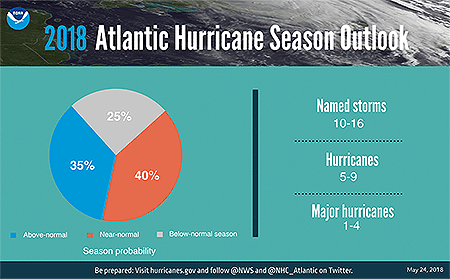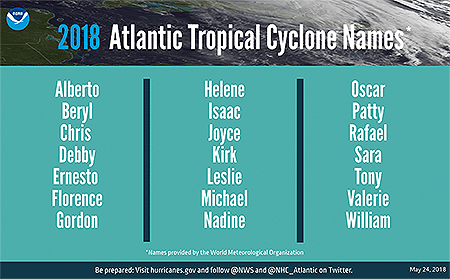It’s been more than 8 months. Since Maria. Irma before. And Harvey before that. For many who endured them, it was yesterday. And here we are at the start of another hurricane season.
 What can we expect? It is nearly indisputable that there will be hurricanes. NOAA’s forecast issued last week calls for 5-9 of them this year. Will they strike land? Science can’t yet say whether any hurricanes and tropical storms will or won’t later this season. It depends on atmospheric steering currents in the Atlantic basin and how they set up this year, particularly during the heart of the six-month season—from August through October.
What can we expect? It is nearly indisputable that there will be hurricanes. NOAA’s forecast issued last week calls for 5-9 of them this year. Will they strike land? Science can’t yet say whether any hurricanes and tropical storms will or won’t later this season. It depends on atmospheric steering currents in the Atlantic basin and how they set up this year, particularly during the heart of the six-month season—from August through October.
But new research is looking beyond this season, beyond many seasons, and is discovering a different type of hurricane season less than 80 years from now, as Earth’s climate warms.
The new study published in the Journal of Climate finds that near-future hurricanes will be wetter and stronger, and they likely will move slower than before, increasing the risk of serious landfall flooding.
Scientists analyzed more than 20 recent hurricanes to determine how they might change near the end of this century, assuming an increase in global temperatures. One such hurricane—Ike from 2010, which inundated coastal Texas, killing more than 100 people and obliterating the popular Bolivar Peninsula barrier island north of Galveston, would have 13 percent stronger winds, move 17 percent slower, and be 34 percent wetter in a warmer world.
Others might move faster and be slightly weaker. But none of the storms reanimated in the future became drier.
“Our research suggests that future hurricanes could drop significantly more rain,” says NCAR scientist Ethan Gutmann, who led the study. Hurricane Harvey unloaded three to four feet of rain in a wide swath from Victoria, Texas, across the Houston area and into Port Arthur in extreme eastern Texas, breaking records and causing devastating flooding, and demonstrating “just how dangerous that can be,” Gutmann says.
That danger is being magnified as coastal populations continue to exponentially grow. “The potential influence of climate change on hurricanes has significant implications for public safety and the economy,” NCAR stated in a release about the new research. The study showed that “the number of strong hurricanes, as a percent of total hurricanes each year, may increase,” Ed Bensman, an NSF program director in the Division of Atmospheric and Geospace Sciences, says. “With increased development along coastlines, that has important implications for future storm damage.”
NSF supported the study, which viewed future hurricanes for the first time collectively at high resolution. Past studies looking at how hurricanes may change in a warmer climate have relied on climate model projections that are determined on a global scale and with temporal resolution of decades to centuries. Their resolution is too low to “see” future hurricanes. Weather models, on the other hand, can see them, but they aren’t used to see long-term because of the high costs of running them.
With the new research, scientists made use of an enormous NCAR dataset and ran the Weather Research and Forecasting (WRF) model at a high resolution (4 kilometers, or about 2.5 miles) focused on the lower 48 United States for two 13-year periods. The first determined the weather as it happened between 2000 and 2013 and the second simulated the same weather but with a climate 5° C (9° F) hotter and subsequently wetter that was warmed near the end of this century by unabated greenhouse gas emissions.
Comparing 22 historic Atlantic hurricanes to the same number of future hurricanes with very similar tracks found a collective 6 percent increase in top wind speeds, but a 24 percent increase in average rain rates. The future storms moved 9 percent slower than in the past.
Individually, each hurricane was unique, some changing one way and others differently. All were rainier. And while other studies have suggested that increases in atmospheric stability and wind shear may lower the total number of annual hurricanes and tropical storms, “from this study we get an idea of what we can expect from the storms that do form,” Gutmann says, and they are likely to be more intense.
 There isn’t a way to tell yet what this year’s hurricanes will be like. But it’s another year into our warming world, and this is yet another study pointing to ominous changes with hurricanes in our future.
There isn’t a way to tell yet what this year’s hurricanes will be like. But it’s another year into our warming world, and this is yet another study pointing to ominous changes with hurricanes in our future.